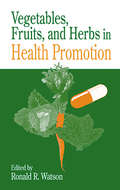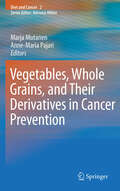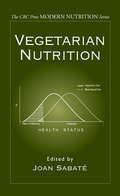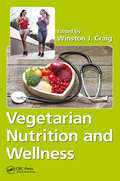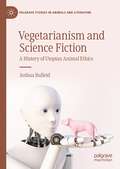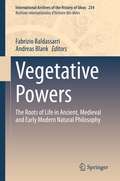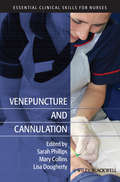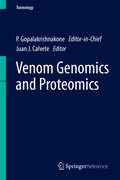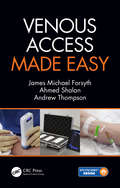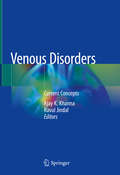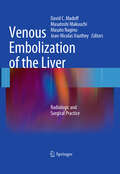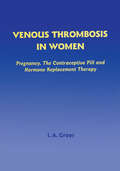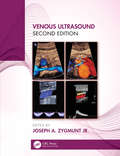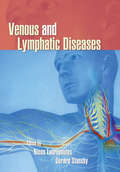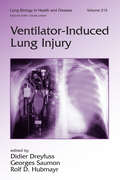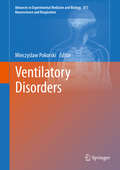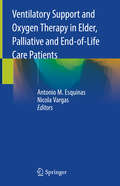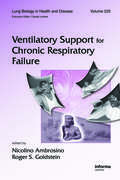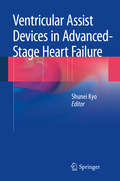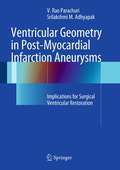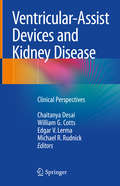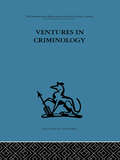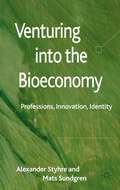- Table View
- List View
Vegetables, Fruits, and Herbs in Health Promotion
by Ronald R. WatsonThe use of dietary vegetables and medicinal herbs to improve health is a phenomenon that is taking society by storm. Herbal products are now a multi-billion dollar business. Even more important, this business is built upon extremely little research data. The FDA is pushing the industry-with Congress' help- to base their claims and products on scien
Vegetables, Whole Grains, and Their Derivatives in Cancer Prevention
by Anne-Maria Pajari Marja MutanenVegetables, Whole Grains and their Derivatives in Cancer Prevention looks in detail at the evidence regarding the effects and mechanisms of action of potentially cancer-preventive components and their sources from plant kingdom. The book covers current knowledge on certain foods and their constituents in cancer prevention, such as cruciferous and green leafy vegetables, nuts and seeds, whole grains, tomato lycopene and carotenoids, alliums and their sulphur and selenium constituents, and capsaicinoids from chilli peppers. It focuses not only on single compounds but aims to widen the view by discussing a whole-diet approach in cancer prevention. A single component may lose its chemopreventive efficacy when isolated from the food matrix and in many cases isolated and concentrated components as supplements may actually induce tumor development. Apart from describing the effects and mechanisms of action, the chapters also contain information on intake, bioavailability, metabolism and possible toxic effects of foods and components presented. Evaluation and comparison of the data from mechanistic studies in vitro with those from animal experiments in vivo form a basis for applying the current knowledge to human nutrition in the field of carcinogenesis. With contributions from leading experts in the field, this book is an invaluable resource for scientists and professionals working in cancer research, as well as individuals involved in food and nutrition.
Vegetarian Nutrition (Modern Nutrition)
by Joan SabatéApproximately 12 million U.S. citizens consider themselves vegetarians, and 13.5 percent of all U.S. households claim to have at least one family member practicing some form of vegetarianism. In the past 30 years, scientific endeavors in the area of vegetarian nutrition have progressively shifted from investigating dietary concerns held by nutritio
Vegetarian Nutrition and Wellness
by Winston J. CraigA large amount of research effort goes into assessing the health benefits of a plant-based diet, resulting from human desire to consume a more sustainable diet that is less destructive of the earth’s natural resources. In addition, a growing number of people are choosing the vegan or total vegetarian diet because of the potential to greatly reduce the risk of chronic diseases and mortality rates. Although this interest in plant-based eating is popular, there exist concerns on the safety of some vegetarian diets, especially a vegan diet. This book describes issues of the vegetarian diet and outlines ways to prevent nutrient deficiencies. Vegetarian Nutrition and Wellness focuses on synthesizing research around vegetarian diets and human health. A major section of the book deals with how a vegetarian diet protects population groups from the major chronic diseases, such as cardiovascular diseases, obesity, and various cancers. Based upon ecological and clinical studies, chapter authors explain the health-promoting properties of plant-based diets, and compare/contrast health outcomes obtained from consuming omnivorous diets with a vegetarian or vegan diet. Fruits and vegetables figure prominently in vegetarian diets and provide a substantial effect in disease reduction and health-promoting properties of a plant-based diet. Vegetarian Nutrition and Wellness is written for the academic community, registered dietitians, health professionals, and graduate students in nutrition and public health. Each chapter provides a comprehensive review of the scientific literature and includes a concise summary at the beginning of each chapter. The time is ripe for this book to update the scientific community with a collage of well-documented topics on vegetarian nutrition.
Vegetarianism and Science Fiction: A History of Utopian Animal Ethics (Palgrave Studies in Animals and Literature)
by Joshua BulleidVegetarianism and Science Fiction: A History of Utopian Animal Ethics examines how vegetarian ideals promoted within science fiction and utopian literature have had a real-world impact on the awareness and spread of vegetarianism and animal advocacy, as well as how the genres' engagements have been altered to reflect changes in ethical and environmental philosophy. Author Joshua Bulleid examines the representation of vegetarianism in the works of major science fiction authors, including Mary Shelley, H. G. Wells, Arthur C. Clarke, Philip K. Dick, Ursula K. Le Guin, Ernest Callenbach, Marge Piercy, Octavia E. Butler, Kim Stanley Robinson and Margaret Atwood within their evolving social contexts, tracing the development of vegetarian trends and their science fictional representations from the early-nineteenth century to the present day.
Vegetative Powers: The Roots of Life in Ancient, Medieval and Early Modern Natural Philosophy (International Archives of the History of Ideas Archives internationales d'histoire des idées #234)
by Andreas Blank Fabrizio BaldassarriThe volume analyzes the natural philosophical accounts and debates concerning the vegetative powers, namely nutrition, growth, and reproduction. While principally focusing on the early modern approaches to the lower functions of the soul, readers will discover the roots of these approaches back to the Ancient times, as the volume highlights the role of three strands that help shape the study of life in the Medieval and early modern natural philosophies. From late antiquity to the early modern period, the vegetative soul and its cognate concepts have played a substantial role in specifying life, living functions, and living bodies, sometimes blurring the line between living and non-living nature, and, at other moments, resulting in a strong restriction of life to a mechanical system of operations and powers. Unearthing the history of the vegetative soul as a shrub of interconnected concepts, the 24 contributions of the volume fill a crucial gap in scholarship, ultimately outlining the importance of vegetal processes of incessant proliferation, generation, and organic growth as the roots of life in natural philosophical interpretations.
Venepuncture and Cannulation
by Mary Collins Sarah Phillips Lisa DoughertyVenepuncture and cannulation are the most commonly performed invasive procedures in the UK, and are everyday procedures in health care practice. Venepuncture and Cannulation is a practical guide to these procedures. It assumes no prior knowledge and equips nurses and other health professionals with the clinical skills and knowledge they need in order to confidently perform venepuncture and cannulation in both hospital and community settings.Explores relevant anatomy and physiologyCovers education and training, as well as legal and ethical issuesConsiders potential complications, and patient perspectivesProvides guidance on the selection of the appropriate vein and equipment, and common blood tests
Venom Genomics and Proteomics
by P. Gopalakrishnakone Juan J. CalveteThis volumeprovides the reader with recent advances in the fields of molecular toxinology,the biotechnological applications of venom toxins, and antivenom production. The content of the twenty chapters of Venom Genomics and Proteomicsillustrates not only the enormous progress made since the implementation ofomics technologies in the field of toxinology, but one also realizes the roadstill ahead to reach a holistic view of venomous systems. Advancement inhigh-throughput technologies in the field of venomics has resulted in theability to generate comprehensive venom profiles for many species. However,research on snake genomes is still in its infancy, although such studies areeagerly awaited to gain insights into the evolutionary history of snake venomproteins, including the mechanisms that originated venom and the regulation oftoxin expression. Fortunately, this objective is also at the reach of currentomic technologies. Therefore it would not be unrealistic to predict a brightnear future to the field of molecular toxinology. VenomGenomics and Proteomics covers research into the venom of scaled reptiles (lizards andsnakes), scorpions, spiders, ants and platypuses. Special consideration isgiven to a number of observations made in the area of snake venom and in theapplication of advanced genomics and proteomics techniques on a variety ofvenom samples. The final chapters give some insight into the potential clinicaluses of venom derivatives and into the importance and challenges faced in theproduction and quality control of antivenoms.
Venom: The Secrets Of Nature's Deadliest Weapon
by Ronald Jenner Eivind UndheimVenom brings readers face to face with some of the most dangerous creatures on the planet, including jellyfish, snakes, and wasps, as it uncovers the story of venom. The book explores how venom is used for predation, defense, competition, and communication by an incredible diversity of species. It examines the unique methods that these species have evolved to create and deliver their deadly toxins. The book traces venom back to its origin in early jellyfish and sea anemones, and reveals how venoms have evolved dozens of times independently all across the animal kingdom since that time. And finally, it examines the relationships between these dangerous creatures and humans. Humans have not only learned to live with them, but also to benefit from them: scientists increasingly are harnessing the power of venom to create new drugs, treatments, and anti-venoms.
Venous Access Made Easy
by James Forsyth Andrew Thompson Ahmed ShalanThis book provides simple and practical instructions on how to perform safe and easy venous cannulation, and how to insert midlines and PICC lines using ultrasound. It aidsunderstanding of the relevant anatomy, shows how to use the ultrasound machine, and how to insert such lines using ultrasound guidance. Readers will feel confident and well prepared to deal with patients requiring difficult venous access, giving them simple solutions that can be learned very quickly. These skills will also be globally beneficial for patients and healthcare institutions alike. Follows the trends of the NHS and riding the wave of the midline/PICC line revolution Compact and affordable highly relevant to daily practice Useful for specialists and generalists alike, truly multi-disciplinary
Venous Disorders: Current Concepts
by Ajay K. Khanna Ravul Jindal<p>Venous disorders are extremely common in clinical practice, and recent years have seen a number of changes in the treatment of these conditions. <p>This book covers the advances in our understanding and the management of venous disorders – both superficial and deep. It includes up-to-date reviews on the hemodynamics of venous circulation in the lower limbs, deep venous reflux, novel biomarkers in deep vein thrombosis, post thrombotic syndrome, infra-popliteal DVT, relevance of wave length in laser treatment of varicose veins, pelvic congestion syndrome, May-Thurner syndrome, nut cracker syndrome, endothermal heat-induced thrombosis, recurrent varicose veins, and venous trauma. It also discusses important topics such as one-stop vein clinics, alternatives for venous ulcer treatment, venous anatomy, therapeutic options in lymphedema, nerve damage during endovenous thermal ablation, newer oral anticoagulants, compression therapy for venous ulcer, sclerotherapy for varicose veins and thrombolysis for DVT. <p>Written by leading experts in their field, this book is a key resource for practicing vein physicians and surgeons, and postgraduates in surgery training programs, enabling them to incorporate the latest advances into their day-to-day practice.</p>
Venous Embolization of the Liver
by Jean-Nicolas Vauthey David C. Madoff Masato Nagino Masatoshi MakuuchiVenous Embolization of the Liver: Radiologic and Surgical Practice explores the theoretical advantages and clinical implications for utilizing Venous Embolization techniques, including portal vein and hepatic vein embolization. The practice of venous embolization of the liver was originally developed in Japan by Dr. Makuuchi (one of the co-editors of this book) in 1990 and since then, the techniques reviewed in this book are practiced throughout the world and are now considered the "standard of care" at many hepatobiliary centres worldwide. Venous Embolization of the Liver: Radiologic and Surgical Practice covers a multitude of topics, including: pertinent vascular (microscopic and macroscopic) and surgical anatomy, liver regeneration (including the atrophy-hypertrophy complex), historical perspectives of major hepatic resection, various hepatobiliary surgical procedures , factors affecting hypertrophy, pathophysiology of embolization and resection, embolization techniques (including approaches and embolic agents), the indications for embolization and resection (including pre-operative volumetric and functional assessment and post-embolization followup), potential complications, outcomes data for different diseases, recently advocated strategies (including "definitive" treatment of hepatocellular carcinoma using portal vein embolization after transcatheter arterial chemoembolization) and future perspectives. This book is a valuable resource for interventional radiologists and hepatobiliary surgeons who perform the embolization procedures and liver resections. Venous Embolization of the Liver: Radiologic and Surgical Practice can also be used secondarily by diagnostic radiologists, medical oncologists specializing in gastrointestinal malignancies, hepatologists, gastroenterologists, liver transplant surgeons and basic scientists interested in liver regeneration physiology research.
Venous Thrombosis in Women: Pregnancy, the Contraceptive Pill and Hormone Replacement Therapy
by Ian A. GreerThe impact of hormones on deep venous thrombosis is one of the most charged and debated subjects in contraceptive medicine. Female hormonal balance is primarily affected by the use of either oral contraceptives or HRT. For a long time it has been recognized that oral contraceptives can raise the incidence of DVT; however, there has been an enormous controversy as to whether all progestins do this equally or whether some have a greater impact than others where oral contraception is concerned. Written by a world leader on the subject, this book offers the latest clinical information about the effects of pregnancy, the contraceptive pill, and hormone replacement therapy on thrombotic problems in women.
Venous Ultrasound
by Joseph A. ZygmuntVenous Ultrasound 2e is the essential text for anyone involved in the treatment of chronic venous disease. It provides specific information on ultrasound as it is applied to chronic insufficiency, including history, general techniques, examples of anatomy, and protocols for performing ultrasound on patients, and discussions on key aspects of interpretation of sonographic findings. Updated to include the outcome and impact of three recent studies, the ATTRACT trial, the EVRA study, and the VIDIO imaging trial. An entire chapter is dedicated to iliac venous and stent imaging for those interested in expanding practice based on the mentioned studies. Also included is specific protocol for imaging of the pelvic area with focus on the pelvic congestion and reflux affecting this anatomic area. This text demonstrates that as imaging techniques improve, so too will the understanding of venous pathologies increase and the burdens of their respective pathologies. Pelvic Congestion, iliofemoral and late stage disease can be interrogated with a non-invasive approach using the techniques included prior to interventional procedures. This fully updated new edition includes coverage of new ablation techniques which include non- thermal and non- tumescent therapies for venous insufficiency – these have unique ultrasound properties on what to see, look for and observe in intra and post- operative situations. Focusing on the fundamentals that every phlebologist needs to know, the color illustrations and numerous line drawings complement the text for a complete learning experience. Key features: Covers anatomy related to venous insufficiency and obstruction Protocols with step by step approaches for those new to certain exams Includes useful diagrams and images to aid understanding Thoroughly up to date, with all the latest information for those practicing venous therapies Venous Ultrasound 2e is valuable for sonographers and physicians alike; including phlebologists, general and vascular surgeons, physicians, radiologists, angiologists, interventional cardiologist, mid-levels, and nurses who work in this area.
Venous and Lymphatic Diseases
by Ramjee PrasadWith an invaluable selection of color images, this guide authoritatively covers the identification, assessment, pathophysiology, epidemiology, and treatment of disorders affecting the venous and lymphatic anatomy. Written by experts from several fields, this source considers topics including the management of deep venous thrombosis, chronic venous
Ventilator-Induced Lung Injury (Lung Biology in Health and Disease)
by Didier Dreyfuss Georges Saumon Rolf D. HubmayrThis reference surveys current best practices in the prevention and management of ventilator-induced lung injury (VILI) and spans the many pathways and mechanisms of VILI including cell injury and repair, the modulation of alveolar-capillary barrier properties, and lung and systemic inflammatory consequences of injurous mechanical ventilation. Cons
Ventilatory Disorders
by Mieczyslaw PokorskiRespiratory function is a major determinant of the overall quality of health and well-being of an individual. This book runs the gamut of chapters devoted to chronic cough-related conditions in children and adults, health care quality and safety, environmental pollution health effects, efficiency of therapeutic approaches and a mutual dependence of respiratory and non-respiratory illnesses. An integrated approach to the investigation and treatment of sleep disordered breathing as well as the use of new and more efficient diagnostic strategies for pleural tuberculosis are presented. Chapters focus on translating science into practice, with an eye on presymptomatic identification of serious ailments for which there could be more effective therapy, leading to improved general health outcomes. This book includes chapters about disorders which will be of interest to clinicians, family practitioners and medical researchers.
Ventilatory Support and Oxygen Therapy in Elder, Palliative and End-of-Life Care Patients
by Antonio M. Esquinas Nicola VargasThis book provides readers with a comprehensive and up-to-date guide to non-invasive mechanical ventilation in palliative medicine, focusing on why and when it may be necessary. Physicians will find a practical guide to this specific context, particularly focused on pulmonary function and physiology in the elderly, and on ventilatory management in surgery and chronic stable conditions. The book provides detailed information on the rationale for invasive and non-invasive ventilation, the different modes of ventilation, indications and contraindications, prognostic factors, and outcomes. It addresses in detail the role of postoperative mechanical ventilation following various forms of surgery, and discusses key aspects of withdrawal from ventilatory support. Attention is also devoted to the use of mechanical ventilation within and beyond the ICU. The concluding part of the book focuses on important topics such as ethics, legal issues, home mechanical ventilation, drug therapy, rehabilitation and end-of-life.Its multidisciplinary approach, bringing together contributions from international experts in different specialties, ensures that the book will be of interest to a broad range of health professionals involved in the management of older patients admitted to the ICU, including intensivists, anesthesiologists, and geriatricians.
Ventilatory Support for Chronic Respiratory Failure
by Nicolino Ambrosino Roger S. GoldsteinAs our population continues to grow, more and more patients are becoming dependent on long-term ventilatory support. Therefore, the need for quality options such as home mechanical ventilation is fast becoming a necessity. Ventilatory Support For Chronic Respiratory Failure (CRF) is the first resource to authoritatively address the needs of the acu
Ventricular Assist Devices in Advanced-Stage Heart Failure
by Shunei KyoThis book focuses on how ventricular assist devices (VADs) can help provide destination therapy for patients with terminal heart failure, one of the most serious diseases in the world today because of the tremendous number of patients, the high mortality rate, and the cost of care. One means of providing cardiological support for patients suffering from heart failure is with VADs, and more than 10,000 patients worldwide have now been implanted with these devices. Half of them already have lived more than one year, and 2,000 patients more than two years, after surgery. This improved survival means that we have reached a point where VADs can be used for destination therapy, not just for bridge-to-recovery or bridge-to-transplant. In view of the increasing number of patients with advanced-stage heart failure and the availability and longevity of transplanted hearts, VADs can solve many problems. In addition to providing information about the devices themselves, this book includes vital guidelines on long-term management and support of VAD-implanted patients' everyday lives.
Ventricular Geometry in Post-Myocardial Infarction Aneurysms
by Srilakshmi AdhyapakThe topic of heart failure although extensively researched and reported, has several gray areas. This is especially seen in determining strategies for combating advanced heart failure. The global burden of ischemic heart disease is increasing at an alarming rate to almost pandemic proportions. Even in the presence of state-of the art technology for prompt and successful coronary reperfusion, the population progressing to ischemic cardiomyopathy is substantial. The treatment strategies for ischemic cardiomyopathy do not always ensure optimal clinical results, the reasons for which are varied. The proper patient selection is vital as is the tailoring of suitable therapy. The approach is thus multi-pronged, of which surgical ventricular restoration (SVR) has a definite role. Despite various randomized studies like the STICH-hypothesis 2, where there was a huge selection bias, with patients subjected to an erroneous technique of SVR, with inadequate ventricular remodelling assessment. The present need is to understand the unique anatomy of the left ventricle, its function and perturbations with the onset of heart failure, in order to plan therapeutic strategies to restore near normal anatomy and function. A study of the hemodynamics in ischemic cardiomyopathy is essential, as it differs in certain aspects from other causes of heart failure like idiopathic dilated cardiomyopathy and valvular heart diseases. Since information on these aspects are scattered in various scholarly articles, a concise source in the form of a book would be appropriate and useful for both cardiologists and cardiac surgeons. This project represents a concise review of normal and abnormal cardiac anatomy and physiology, the evolution of SVR to EVLPP with validation of near normal ventricular restoration, plus act as a reference guide for cardiac surgeons with interest in SVR.
Ventricular-Assist Devices and Kidney Disease: Clinical Perspectives
by Edgar V. Lerma Chaitanya Desai William G. Cotts Michael R. RudnickThis text serves as a convenient one-stop resource on the pathogenesis, diagnosis and treatment of kidney diseases in context of advanced heart failure and presence of ventricular assist devices. Advances in managing heart failure, evidence-based practices and therapies are covered, along with the management of this unique and complex subset of patients. The book also provides insights into combined heart and kidney transplantation. Authored by leaders in nephrology, cardiology and transplantation, this book fills a critical knowledge gap in understanding and treating patients with acute or chronic dysfunction of the heart and kidneys and how one induces dysfunction in the other organ.
Ventures in Criminology: Selected recent papers
by Sheldon Eleanor GlueckTavistock Press was established as a co-operative venture between the Tavistock Institute and Routledge & Kegan Paul (RKP) in the 1950s to produce a series of major contributions across the social sciences. This volume is part of a 2001 reissue of a selection of those important works which have since gone out of print, or are difficult to locate. Published by Routledge, 112 volumes in total are being brought together under the name The International Behavioural and Social Sciences Library: Classics from the Tavistock Press. Reproduced here in facsimile, this volume was originally published in 1964 and is available individually. The collection is also available in a number of themed mini-sets of between 5 and 13 volumes, or as a complete collection.
Venturing into the Bioeconomy
by Alexander Styhre Mats SundgrenThis bookreports empirical material from three case studies in the pharmaceutical industry, the biotechnology industry and the domain of academic research. New technoscientific frameworks that have not yet translated into new therapies, in the future, may play a more central role in the late-modern society. "
Verantwortung wahrnehmen als Verantwortung aus Leidenschaft (essentials)
by Philipp StoellgerIst Verantwortung als Pflicht zu verstehen – oder auch als Leidenschaft, als Passion für den Nächsten? Der hier gewagte Versuch plädiert für solch ein leidenschaftliches Verständnis von Verantwortung. Denn der Ruf nach Verantwortung kommt immer schon zu spät: wenn sie nicht wahrgenommen wurde. Wo aber entsteht sie und warum sollte man Verantwortung übernehmen? Aus zwingenden Gründen oder traditionellen Verpflichtungen? Will man heute Verantwortung neu wahrnehmen, lohnt sich der Versuch, sie neu zu verstehen: Verantwortung als etwas Fragiles und Vulnerables; als eine unausweichliche und unwillkürliche Antwort auf den Anspruch des Anderen – als eine Leidenschaft für den Nächsten.
